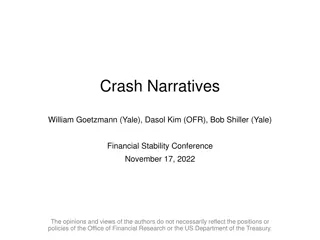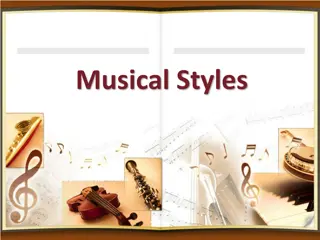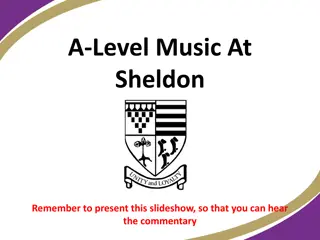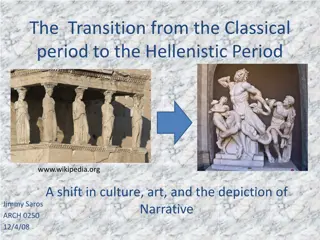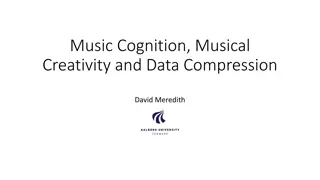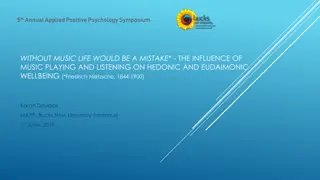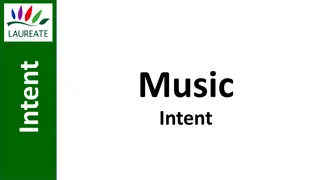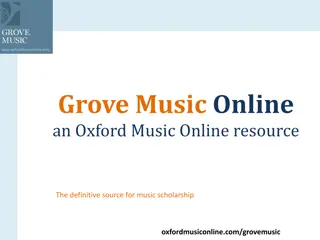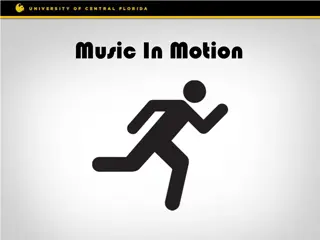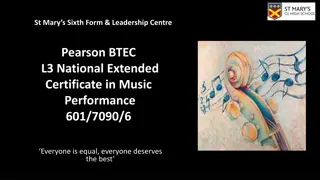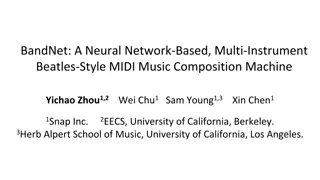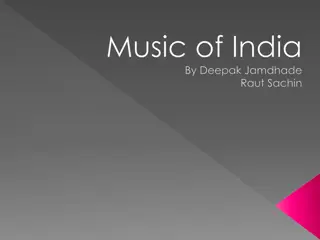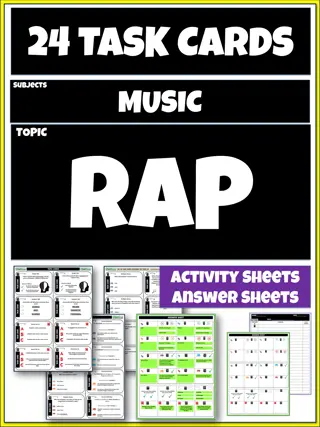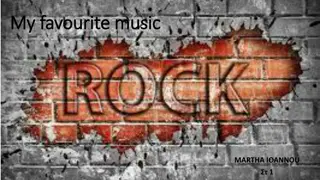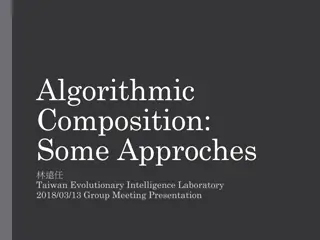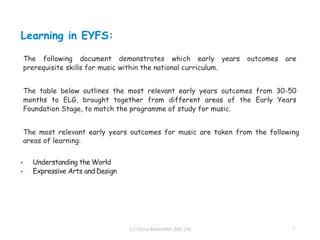Exploring Historical Narratives through Music and Art
This submission presents two original compositions that delve into historical narratives through a unique blend of music and visual art. The compositions aim to reinterpret stories from the past, creating innovative structures and forms. By intertwining various perspectives and utilizing cinematic techniques, the works offer a fresh perspective on historical events, inviting the audience to engage with ambiguity and complexity. Through a multi-layered approach, the compositions challenge traditional storytelling methods and explore the intersections of music, poetry, and historical context.
Download Presentation

Please find below an Image/Link to download the presentation.
The content on the website is provided AS IS for your information and personal use only. It may not be sold, licensed, or shared on other websites without obtaining consent from the author. Download presentation by click this link. If you encounter any issues during the download, it is possible that the publisher has removed the file from their server.
E N D
Presentation Transcript
Autoethnographic Autoethnographic Compositional Compositional Responses to Responses to Historical Narratives. Historical Narratives. UoA 33 Multi-component Output with contextual information David Lancaster 2016-18 Fig. 1 Medieval Wall Painting, Pickering.
Index of Contents 300 word statement 3 Research Objectives 4 Process and dissemination 5-6 Scores and Recordings 7 Bibliography 8 Fig. 2 Student demonstrations at Tlatelolco, Mexico 1968 2
Autoethnographic Compositional Responses to Autoethnographic Compositional Responses to Historical Narratives Historical Narratives 300 word statement This submission comprises two original compositions for voice(s) and ensemble, developing important themes from recent work: Firstly, it continues an ongoing autoethnographic study which seeks to understand the world through an exploration of older narratives, buildings, artefacts and images; secondly, it is concerned with the re-telling of narratives from the past in such a way as to create new forms and structures. Both compositions are re-interpretations of material from historical sources; Ellis and Bochner (2000, 739) state that autoethnographers gaze, first focusing outward on social and cultural aspects of their personal experience; then, they look inward, exposing a self that is moved by and may move through, refract, and resist cultural interpretations , favouring instead the personal and subjective readings. The multi-layered nature of the poetry (in Tlatelolco) re-tells events from multiple perspectives, revealing ambiguities and inconsistencies in the reporting of the massacre and providing opportunities for multiple parallel musical settings. In Music of a Thousand Breaths that ambiguity is provided through simultaneous visual, musical and poetic re-tellings. In either case the overarching structure of the work is determined by an external source - the sequence of paintings around the nave of the church, or the poetic text - but linear continuity is deliberately broken by the fragmented, episodic form and a web of musical cross- referencing to create a fractured continuity which draws extensively upon techniques of analepsis and prolepsis from cinematography. In Tlatelolco, for example, the narrative cuts between the three voices, often rapidly, to establish a quasi-cinematic montage; transitions are sometimes smooth crossfades but in other places are harder cuts, without transition. Whilst del Rio tells the story of the events in the order they unfold, the use of multiple perspectives dramatizes that narrative and the disjunct continuity adds to the sense of bewilderment and confusion. 3
Research Objectives Research objective Research objective To develop autoethographic responses to contrasting historical narratives. To research a network of interactions between visual art, poetic text and musical form. Evidence Evidence Score, recording. Score, recording. To research relationships between word and music when poetry delivers multiple narratives. Score, recording. To further my research into cinematic technique/process and musical structure to create new forms of musical narrative. To explore longer musical structures which sustain the integrity of multiple strands whilst maintaining linear continuity. Score, recording. Score, recording. 4
Process and dissemination: Music of a Thousand Breaths This work was created in response to the extensive medieval wall paintings at Pickering Church. It comprises a sequence of vocal and instrumental movements, setting poetry written for this project by Abi Curtis, interspersed with soundscapes produced by David Power. Composed: Spring 2018 Music by David Lancaster, poetry by Abi Curtis Performance: July 2018 at St. Peter and St. Paul's Church, Pickering, North Yorkshire. Scored for five solo voices (soprano, 2 x mezzo soprano, tenor and bass) and brass quartet (flugelhorn and three trombones) with dancer and fixed electronic media. Duration 45 minutes. Link to full programme, including text: https://yorksj- my.sharepoint.com/:b:/g/personal/d_lancaster_yorksj_ac_uk/Ec3zwxwYi1x Djb8_yMw2-DYB0RsA1cP3t7p7SM7B3k2CPA?e=AChJia Fig. 3 Performance Flier, Music of A Thousand Breaths, 2018. 5
Process and dissemination: Tlatelolco: A Song for Three Voices Composed: Spring 2016 Music by David Lancaster, text by Marcela Del Rio (English translation by Victoria Carpenter). Performances: June 2016 (York Festival of Ideas) and October 2018 (Late Music concert series). Scored for soprano voice, cor anglais, bass trombone and marimba. Duration 45 minutes. This monodrama for soprano and ensemble sets a powerful text which documents the 1960 massacre at Tlatelolco, Mexico, through three distinct narrative voices: a third person narrative about a poet being witness to the 1968 Tlatelolco massacre (this text is spoken, accompanied by marimba), her internal monologue, possibly the poem she is writing (this text is sung arioso, accompanied by marimba and cor anglais), quotations from Manuscrito de Tlatelolco, a 16th century account of the fall of the Aztec capital Tenochtitlan (this is more dramatic song, accompanied by full ensemble). Link to full programme, including text: https://1drv.ms/b/s!AlqMggwUEbS9mF8uugDmxX2CQR6d?e=knggVj 6
Scores and Recordings Link to recording: Music of a Thousand Breaths https://www.youtube.com/watch?v=rswCzgZnY9s Link to score: Music of a Thousand Breaths https://yorksj- my.sharepoint.com/:b:/g/personal/d_lancaster_yorksj_ac_uk/Ebp2RB Z1TItMj3_fBT1x96oBAtY-quETQ_2Fu-MkYGKWug?e=d2vsnL Link to recording: Tlatelolco https://1drv.ms/u/s!AlqMggwUEbS9mGE3PVwhZ7cxlq6j?e=y02kS8 Link to score: Tlatelolco https://1drv.ms/b/s!AlqMggwUEbS9mF1uJTxpTWgigLc4?e=L2NaUZ 7
Bibliography Carpenter, Victoria. The Tlatelolco Massacre, Mexico 1968, and the Emotional Triangle of Anger, Grief and Shame The Tlatelolco Massacre, Mexico 1968, and the Emotional Triangle of Anger, Grief and Shame, UWP, Cardiff, 2018 Eisenstein, S.M: Towards a Theory of Montage Towards a Theory of Montage, BFI Publishing, London, 1994 Ellis and Bochner: Autoethnography, Personal Narrative, Reflexivity: Researcher as Subject, Autoethnography, Personal Narrative, Reflexivity: Researcher as Subject, (in Denzin and Lincoln: Handbook of Qualitative Research 2nd Ed.) Sage Publications, New York, 2000 Krauze, Enrico, Symposium 1968 Symposium 1968, Dissent Magazine, Spring 2008. https://www.dissentmagazine.org/article/symposium-1968-enrique-krauze Nelsson, Richard, How the Guardian reported Mexico City's Tlatelolco massacre of 1968 How the Guardian reported Mexico City's Tlatelolco massacre of 1968, The Guardian, 2015 https://www.theguardian.com/cities/from-the-archive-blog/2015/nov/12/guardian-mexico-tlatelolco-massacre- 1968-john-rodda Pevsner, Nikolaus; Yorkshire: The North Riding (Pevsner Architectural Guides), : The North Riding (Pevsner Architectural Guides), Yale University Press, 1981 Pontiowska, Elena, Massacre in Mexico Massacre in Mexico, University of Missouri, December 1991 8


